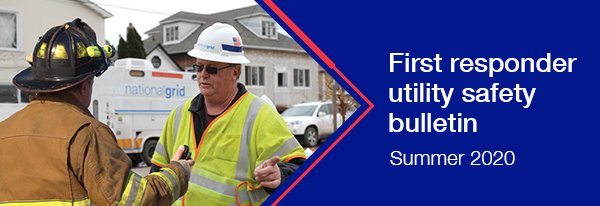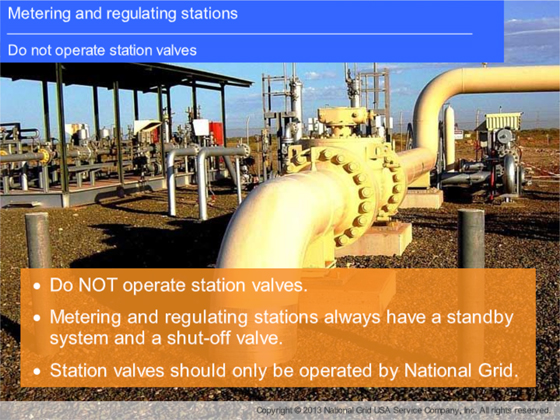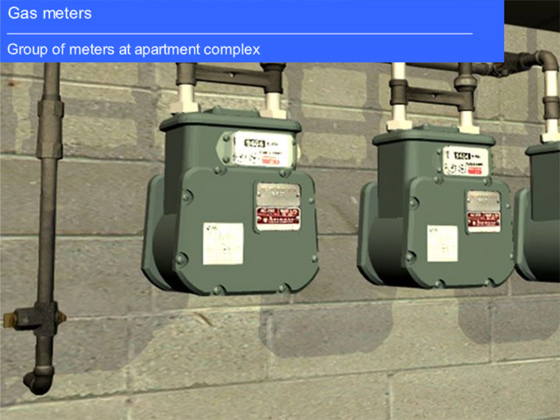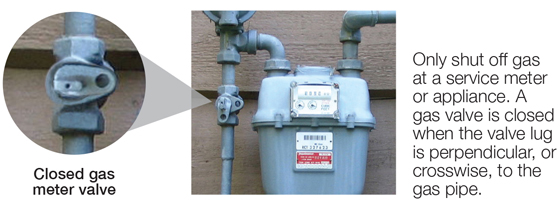 |
| The natural gas distribution system |
| The natural gas pipeline network consists of a series of components that make up a safe and efficient distribution system. Understanding the key features of this system will help you respond more effectively to incidents involving natural gas pipeline leaks and fires. |
| Transmission pipelines. Transmission pipelines carry large volumes of natural gas at high pressure to the National Grid Service area. High-visibility markers indicate the approximate location of transmission pipelines. These markers include the pipeline company’s name, the type of product carried and an emergency phone number. |
|
|
|
|
| Distribution mains. National Grid may send high-pressure gas through its own transmission lines to regulator stations or reduce the pressure as required for the local distribution system. Some large industrial and commercial customers do receive natural gas from National Grid at transmission line pressure before it is reduced; however, most customers are served by lower-pressure distribution mains located beneath public streets. |
| Service laterals. Service laterals carry natural gas from the distribution main to the gas meter located at, or inside, a structure. For most structures, natural gas is supplied by just one service lateral, which varies in size and can be made of steel, plastic or copper. |
| Metering and regulating stations. Metering and regulating stations reduce pipeline pressures so the gas can be safely delivered through the distribution system within the maximum allowable operating pressure. |
 |
| System control valves. Transmission pipelines and most distribution mains are controlled by a series of underground shutoff valves. These valves should only be operated by trained National Grid emergency representatives. Never attempt to open or close underground pipeline or station valves, as doing so could cause dangerous pressure changes in the system. |
| Curb valves. Curb valves are a safety feature often installed on the service lateral. They are located on or near the property line and are accessible from above ground through a curb or gate box. These valves enable National Grid to shut off the natural gas supply to a building, should this be required. (In some parts of National Grid’s operating area, fire departments have been provided specific tools and training for closing curb valves. Only those personnel so trained and equipped should shut curb valves.) |
| Gas meters. Gas meters measure the amount of gas used in a home or building. These meters can be located indoors or outdoors. The meter can be a single unit, or a group of several units joined together. |
 |
| Regulators. If a building’s meter assembly has a regulator, this indicates that a high-pressure service lateral supplies the building. The regulator reduces the pressure of the gas so it can be utilized by the appliances and equipment inside the building. All gas regulators located indoors have piping that vents high-pressure gas outdoors in the event the regulator fails. Regulator vents must be kept clear of snow, ice and debris at all times to ensure safe operation. |
| Service shut-off valves. An individual gas meter typically has a shut-off valve located on the piping that comes out of the ground, before the meter. Grouped meters, such as those for apartment buildings, have individual service shut-off valves for each unit’s meter as well as a master service shut-off valve for the entire building. The master shut-off is usually located near the gas meters, close to the spot where the gas pipeline comes out of the ground or through the wall. First responders may close gas service valves, if necessary, at meters or at appliances. Once any gas valve is closed, only National Grid may re-open it. |
 |
 |
|
|
